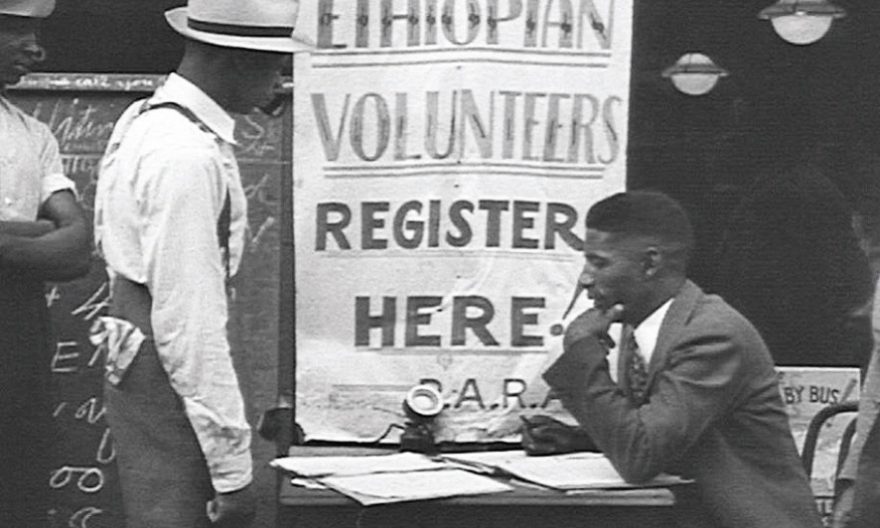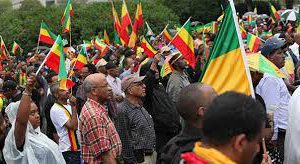
Ethiopians in the diaspora have been waging unreserved struggles in different forms. Many have been staging demonstrations, contributing money, resources and ideas to support their struggle so as to protect the sovereignty of their land of origin.
But such a struggle to protect Ethiopia from forces that attempt to put the sovereignty at stake is not new as there were many predecessors of such struggles in America and Europe since the Battle of Adwa as well as during World War II.
At that moment the number of Ethiopian diasporas was very small if not nonexistent. However, the significant number of black American communities, who live under severe racial discrimination, were brave enough to denounce and rally against the Fascist Italian invasion and aggression against Ethiopia, according to face2faceafrica.com.
When the Second Italo-Ethiopian War, or the Second Italo-Abyssinian War, began in 1935, it raged on for seven months, ending in the military occupation of the African nation. That was Italy’s second attempt at invading Ethiopia. While the rest of Africa was under colonial rule after the infamous partition by European powers at the Berlin Conference of 1884, Ethiopia was then a sovereign nation with a formidable army and a strong monarchy.
A few years after the division of the continent, the Italian Kingdom – which had obtained Eritrea and Italian Somalia as its African territories – wanted to add Ethiopia to its colony on March 1, 1896. But it failed after the defeat of the Italian army in the Battle of Adwa which is also described as the First Italo-Ethiopian War. The battle fought near the northern town of Adwa in Ethiopia’s Tigray Region is the first victory by an African country over a colonial power.
It left a very sour taste in the mouth of Italy so it decided to take revenge in the Second Italo-Ethiopian War (1935 – 1939). Led by Italian leader Benito Mussolini, Italy was successful in that war but not without strong Ethiopian resistance under the leadership of Emperor Haile Selassie I. And many thousand miles away, a Black American community in the U.S. also volunteered to defend Ethiopia when no one else would.
More than 20,000 protestors including both Blacks and sympathetic Whites showed up in the streets of Harlem, New York on August 3, 1935, to demonstrate against Mussolini’s decision to take over Ethiopia. Some 10,000 people also demonstrated in Chicago, according to records. This was amid the Great Depression when it was hard for many to find work and even food. Yet, Blacks in the U.S. were ready to fight for Africa’s last sovereign nation which they saw as their true ancestral homeland and which was for them, a symbol of redemption in the diaspora.
Harlem, which would become popularly known as the Black Cultural Mecca famous for its great jazz clubs, African-American arts, culture, and heritage, was just emerging from its own Renaissance when the war in Ethiopia began. The Renaissance among other things served as a means of achieving equality and civil rights through artistic expression. When news broke that Italy was taking over Ethiopia, Blacks in Harlem, who were loud in resistance and who saw the African nation as an ancient cradle of civilization, were outraged.
Thus, they volunteered to take on Italian dictator Mussolini. Apart from protesting, thousands of them signed up to go and fight for Ethiopia. They were however stopped by the State Department, which threatened jail, adding that the U.S. should only offer medical relief.
But one brave African-American aviator was able to make it to Ethiopia. John C. Robinson, who was recruited by the Ethiopian government to lead its air force, sailed over with the cover story that he was an aircraft dealer, according to one account. Robinson would train many Ethiopians to fly and fix aircraft before returning to New York in 1936 where he was given a hero’s welcome. He later became known as the Father of the Tuskegee Airmen for his immense contributions to the aviation programs he started at the Tuskegee Institute in Alabama in the early 1940s.
The “Walwal Incident” in December 1934 was the reason Italian leader Mussolini decided to invade the country. Walwal, an eastern city, sat near a border, where a clash between the Kingdom of Italy and Ethiopia led to the death of 150 Ethiopians and two Italians.
On the eve of the attack, Ethiopian leader Haile Selassie I ordered men from the country to assemble and defend its lands. Although his troops outnumbered Mussolini’s, many of Selassie’s men were armed with primitive weapons and even more had no experience with military operations.
Mussolini’s forces entered Ethiopia from Eritrea, yet they did not declare war. Selassie took the crossing of borders as an affront and ordered the first of his offensive manoeuvres, yet he was continually outgunned by the more experienced and well-equipped Italians.
For the next few months, many cities fell to Italy and fell under the Fascist rule of Mussolini. The Ethiopian forces were spirited, however, doing their best to pluck off enemy forces. Mussolini used chemical warfare (pictured) after Ethiopian soldiers down an Italian air pilot, sending a message to Selassie’s army.
The following May, Selassie fled to Europe in exile and did so with the blessing of the Italians who could have stopped his progress. Widespread rioting and looting took place when Selassie took leave, which was quelled by the emergence of Italian forces. Perhaps because of the fatigue of war and the lack of Ethiopian governance, a truce of sorts took place in June.
On June 1, 1936, Italy officially joined Ethiopia with Eritrea and Italian Somaliland. The new state was known as Africa Orientale Italiana (Italian East Africa).
BY STAFF REPORTER
THE ETHIOPIAN HERALD AUGUST 31/ 2021




